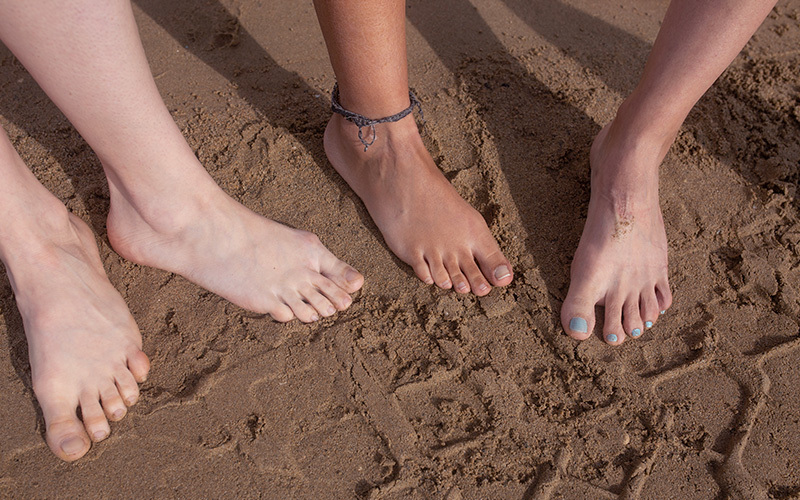A new option for teens with painful bunions

Bunions, bumps at the base of the big toes, are probably not at the top of most kids’ list of concerns. Adults, particularly adult women, are far more likely to develop bunions, possibly after years of wearing tight shoes that squeeze their toes.
In children and teens who have them, bunions are almost always an inherited family trait. Some conditions, such as cerebral palsy and Down syndrome increase a child’s risk of having bunions. Yet some bunions become large and painful and make it hard to wear shoes. Conservative treatments, like switching to well-fitting shoes or adding an orthotic inside the shoes, usually relieve the pain. In rare cases, however, children need bunion surgery.
One of the drawbacks of traditional bunion surgery is the long and often painful recovery. Adults with bunions have had a minimally invasive option with a much shorter recovery time since the late 1990s. For years, this procedure wasn’t widely used in younger patients — that is slowly changing. Today, a few pediatric orthopedic centers in the U.S., including Boston Children’s Hospital, offer minimally invasive bunion surgery for children and teens.
Dr. Collin May, an orthopedic surgeon in Boston Children’s Lower Extremity Program, started performing minimally invasive bunion surgery on pediatric patients in 2019. Here, he describes the procedure, how it differs from traditional bunion surgery, and what his patients have to say about their experience.
What’s the traditional surgery for bunions in teens?
Traditional bunion surgery involves making a rather large incision on the inside of the toe that allows the surgeon to open the joint at the base of that toe and to cut the metatarsal bone in one or more places, a procedure called an osteotomy. Once the bone is cut, the position of the toe is corrected and the bone is fixed with screws or a plate and screws. Usually, this also involves correcting the tendons and ligaments around the big toe.
What are the drawbacks of traditional bunion surgery?
First, there is a prolonged recovery. Patients typically can’t put any weight on their foot for six or more weeks after an osteotomy. Full recovery takes up to six months. There’s also a high risk of recurrence: Patients have a 15 percent or higher chance that their bunion will return after traditional bunion surgery. For a pretty significant operation, that’s a large number.
How is minimally invasive bunion surgery different?
Compared to the traditional bunion correction, minimally invasive bunion surgery uses smaller tools to cut the bone and adjust the position of the toe. Therefore, we only need to make a few very small incisions, causing much less damage to the soft tissues around the toe.
From what we’ve seen so far, patients experience a lot less pain and recover faster from minimally invasive bunion surgery. Patients who are mature enough to comply with weight-bearing restrictions can put weight on their operative foot right after surgery, as long as they’re in a boot or hard-soled shoe, which they need to wear for the next four weeks.
On average, our patients fully recover from minimally invasive bunion correction in six to 12 weeks.
Does performing bunion surgery on children and teens require special expertise?
Yes. Anyone who operates on a child’s bones needs to understand growth patterns so they don’t unintentionally disrupt the child’s growth. Also, some pediatric bunion correction procedures actually take advantage of the growth to correct the toe’s alignment. These are issues we are very aware of and keep in mind to ensure the best possible outcome for our patients.
In addition, minimally invasive bunion procedures use special equipment that requires training and expertise. We have surgeons with that expertise at Boston Children’s.
What results have you seen in your patients after minimally invasive bunion surgery?
This is a relatively new procedure in the pediatric population so we don’t yet have the benefit of large-scale studies. However, all of the minimally invasive bunion surgeries performed at Boston Children’s so far have corrected our patients’ bunions, and none have recurred.
Patients have generally given us very positive feedback with respect to their recovery and the process overall. A few of our patients had a traditional bunion operation on one foot, before minimally invasive surgery was available, and minimally invasive surgery on the other. Uniformly they have preferred minimally invasive bunion correction to the traditional procedures.
We do not yet know if the low rate of recurrence after minimally invasive bunion surgery in pediatric patients will continue over time. In fact, we are conducting a study looking at that question now. But we feel, given how much less invasive the procedure is than traditional surgery, even if the recurrence risk is similar, it’s a preferable way to correct bunions.
Learn more about the Lower Extremity Program or call for an appointment.
Related Posts :
-

Generations of excellence in lower extremity care: Dr. Kasser and Dr. May
As an orthopedic surgeon and professor of surgery, Dr. James Kasser has spent several decades sharing his expertise in limb ...
-

Clubfoot bracing for an active boy: Finn’s story
When Finn Beaulieu learned how to say elephant, he ran around the house repeating the word at least 20 times. When ...
-

Questions to ask about your child’s orthopedic care
Maybe your child has an orthopedic injury and needs surgery, or maybe they need to be treated with a different ...
-

One day closer: Second opinion for urologic pain changes Iker’s life at last
Like many kids, Iker Guzman enjoys playing with LEGO toys. But there was nothing lighthearted about the day a few ...





